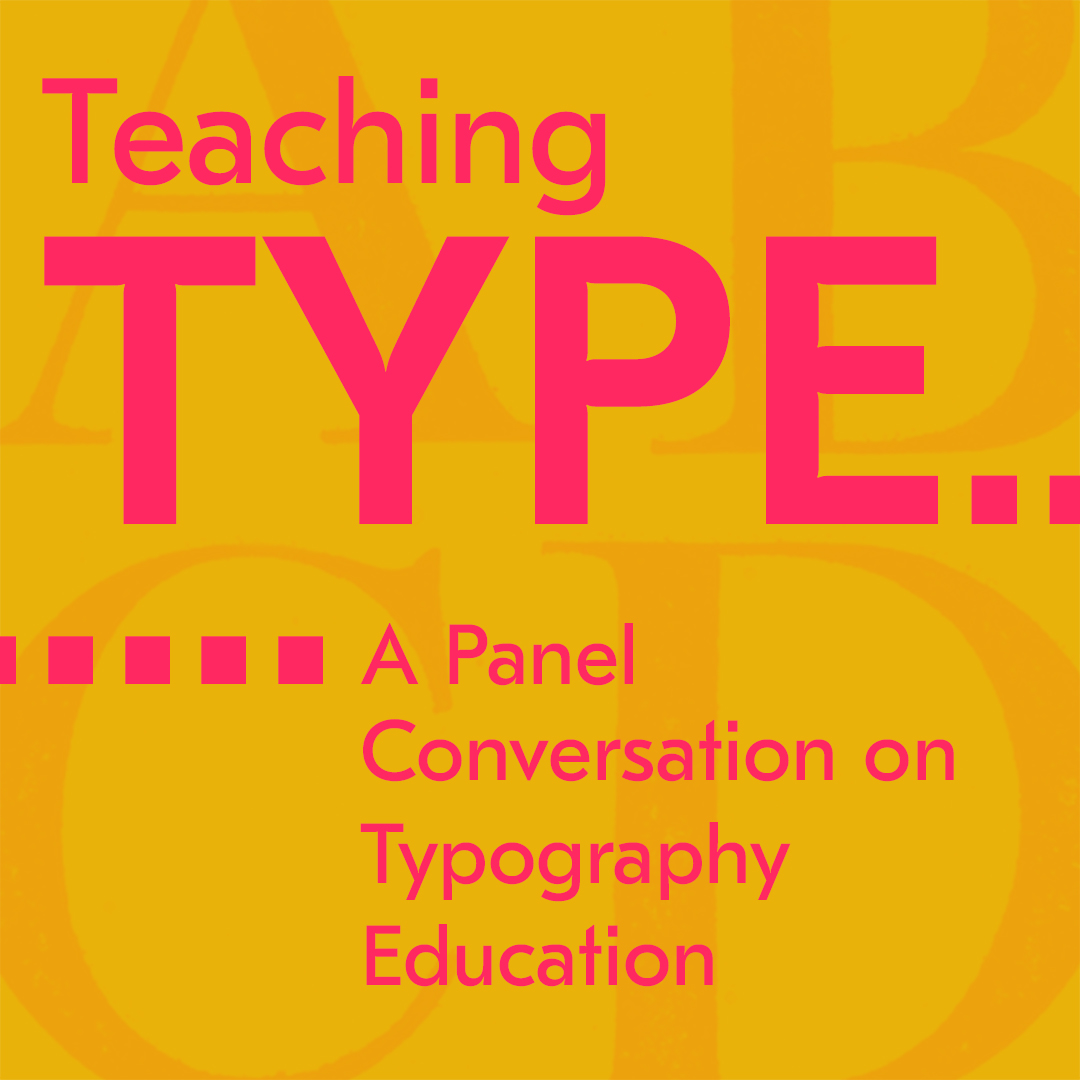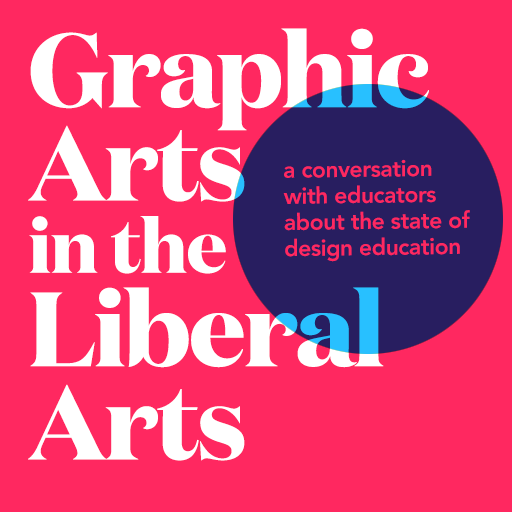Read the interview with Thomas Jockin of Type Thursday, Liz Deluna and Mark Zurolo.
Tag: design pedagogy
Teaching Type: A Panel Conversation on Typography Education
Educators will discuss innovations, challenges and best practices for teaching typography.
As a mainstay of design, typography is a corner stone of most degree programs in visual communication design. Still questions abound. How and where typography is taught is as varied as its use in design applications. We invite you to join fellow educators in a conversation which will focus on how, where and when we teach typography. Our panelists will explore the role of typography in the continuum of design education and identify areas where traditional programs experience shortcomings and challenges. We will ask what fundamental skills should be taught and whether the way we are teaching typography needs to change in a screen-based world? Finally, we will ask the audience to participate in identifying specific skill sets and methodologies which should be part of type-centric design curriculum in the 21st Century.
The conversation will be moderated by Doug Clouse, President of TDC and Principal at The Graphics Office and Liz DeLuna, Associate Professor of Design at St. John’s University.
Type Directors Club
347 West 36th Street
Suite 603
New York, NY 10018
Saturday, April 1, 2017
2pm–5pm
Moderators
Liz DeLuna
Associate Professor of Design
St. John’s University
Doug Clouse
President, Type Directors Club
Principal, The Graphics Office
Panelists
Thomas Jockin
Founder of TypeThursday
Adjunct Professor
Queen’s College, CUNY
and Fashion Institute of Technology, SUNY
Amy Papaelias
Assistant Professor
Graphic Design
SUNY New Paltz
Co-founder of Alphabettes.org
John Gambell
Senior Critic
Yale School of Art
Yale University Printer
Juliette Cezzar
Designer, Writer
Assistant Professor
Communication Design
Parsons School of Design, The New School
Hosted by the Type Directors Club.
Graphic Arts in the Liberal Arts: Panel Discussion @TypeDirectors
Educators discuss Graphic Design Programs at the Type Directors Club, Saturday, November 12, 2016. 2pm–5pm.
What challenges and obstacles do graphic design programs encounter today as they work to balance the multitude of critical thinking, and conceptual and technical skills needed to help students grow into thoughtful, adept and culturally aware design practitioners? How do programs housed in liberal arts institutions differ from those in art schools? We invite you to join educators in a conversation on the teaching of design in institutions with varied pedagogies and student communities.
Moderators
Liz Deluna
Associate Professor of Design
St. John’s University
Mark Zurolo
Associate Professor of Design
University of Connecticut
Panelists
Robin Landa
Distinguished Professor
Robert Busch School of Design
Michael Graves College
Kean University
Allan Espiritu
Associate Professor Graphic Design
Graphic Design Program Director
Rutgers University
Dan Wong
Associate Professor
Communication Design
New York City College of Technology, CUNY
Nick Rock
Assistant Professor Graphic Design
Boston University
Jessica Wexler
Assistant Professor Graphic Design
Purchase College, SUNY
Kelly Walters
Assistant Professor Graphic Design
University of Connecticut
Event Details
 Hosted by Type Directors Club
Hosted by Type Directors Club
Saturday, November 12, 2016
2pm–5pm
Type Directors Club
347 West 36th Street, Suite 603
New York, NY 10018
Please register on AIGA/NY events page here.
Eat Your Vegetables: Sneaking in Conceptual Thinking During Technical Instruction
Suzanne Dell’Orto
Adjunct Lecturer
Fine & Performing Arts
Baruch College, CUNY
“Eat Your Vegetables: Sneaking in Conceptual Thinking during Technical Instruction” is an experiential progression of graphic design projects that helps to introduce and refine the technical skills essential to professional practice. More important, it overlays other 21st century skills, adding pedagogical depth to the skill-building through an implicit layer of meaning-making, critical thinking, and abstract and symbolic thinking.
My introductory graphic design class is mandated to build the skills to communicate ideas and cover the essence of branding (a highly competitive game of attention-getting, recognition and trust), and the class is enriched by the addition of a critical thinking element. Students imagine, conceptualize, then filter and form allegiances to a random “theme word” assigned at the beginning of the semester. The challenge of deepening the development of this key word threads through 15 weeks of instruction, intersecting critical thinking with learning technical skills. This approach also allows the mimicking of a real-life designer/client relationship, using the theme word as a surrogate client. Students also learn and use tools for thinking in the curricular sequence, some borrowed from other domains such as the writing process of “word mapping”.
Attendees will learn, in this illustrated lecture, that the complexities of contemporary professional practice and the competitive global business context demand a critical and creative approach to foundational coursework––well-prepared hands, eyes, and minds.
This research was presented at the Design Incubation Colloquium 3.1: Kean University on Saturday, Oct 22, 2016.Major and Life Design for a Wild New World
Karen M. Cardozo, M.Ed., PhD
Assistant Professor of Interdisciplinary Studies
Massachusetts College of Liberal Arts
Some undergraduate institutions offer an interdisciplinary or special major where students integrate their interests and passions to design their own programs of study. In Finding Your Way in a Wild New World (2013), this method is recommended to everyone by social scientist and life coach Martha Beck. Arguing that social structures (including those related to work) are changing faster than conventional education or strategic planning processes can keep pace, Beck suggests that we can best navigate this rapidly shifting landscape by following our instincts and using all five senses in a more fluid, situationally responsive way. This dovetails with Daniel Pink’s thesis in A Whole New Mind (2006) that we have entered a Conceptual Age in which the most successful enterprises will be “high touch” (providing face to face or interactive services that cannot be outsourced) and/or “high concept” (tapping the creative, visual capacities of the right brain in addition to the analytic, verbal capacities of the left brain that are most elicited by educational systems). Barbara Sher (2006) agrees, adding that integrative or interdisciplinary orientations of the polymath types she calls “scanners” will be particularly in demand. Design communication serves as an ideal nexus for all of these insights.
Inspired by Stanford’s Design your Stanford and Design Your Life courses, this presentation argues that 21st century pedagogy should relinquish an outmoded “information age” attachment to content coverage in favor of more self-reflexive learning in which students apply open-ended and iterative design principles to fully maximize their own curiosity, inclinations and opportunities—in college and beyond. As a concrete case study, we’ll look at MCLA’s Interdisciplinary Studies (IDST) program as helpful “design your major” intervention, and present a scaled-up counterpart in life design from one IDST World of Work course, whose final research project requires students to design their lives in two alternate universes: one, the life they think they are planning and the other a path that might unfold from a different point of departure and in response to unpredicted setbacks, risks taken, or plain dumb chance. The resulting insights reveal that while the future is unpredictable, the value of design thinking as a method for navigating the unknown is quite clear.
This research was presented at the Design Incubation Colloquium 3.0: Massachusetts College of Liberal Arts (MCLA) on Saturday, Sept 24, 2016.The Graphic Design Portfolio: Process Over Product
Irina Lee
Design Director, Bureau Blank
Adjunct Lecturer, School of Visual Arts
Adjunct Lecturer, Department of Visual Communications: Art + Graphic Design
SUNY Farmingdale
Design Incubation Colloquium 1.1: Queens College
Tuesday, August 26, 2014
Conference Room, Klapper Hall
Queens College
65-30 Kissena Blvd.
Queens, NY 11367-1597
Presentations
Definining Practice, Redefining Education: Five Case Studies
Juliette Cezzar
Associate Director & Assistant Professor
BFA Communication Design
Parsons the New School for Design
Reality Check: Learning About the Difference Between Design and Designer
Yue Chen
Art Director
Office of Visual Communication
New York City College of Technology, CUNY
Engaging the Campus Community with Design Thinking
Andrew DeRosa
Assistant Professor
Queens College, CUNY
Attendees
- Liz DeLuna, Associate Professor, St. John’s University
- M. Genevieve Hitchings, Assistant Professor, CityTech—CUNY
- Lisa Maione, Adjunct Lecturer, Parsons—The New School, Queens College—CUNY
- Grace Moon, Assistant Professor, Queens College—CUNY
- Aaris Sherin, Associate Professor, St. John’s University
- Ryan Hartley Smith, Assistant Professor, Queens College — CUNY
- Kathryn Weinstein, Assistant Professor, Queens College—CUNY
- Dan Wong, Assistant Professor, CityTech—CUNY
Reality Check: Learning About the Difference Between Design and Designer
Yue Chen
Art Director
Office of Visual Communication
New York City College of Technology, CUNY
Design critic Ralph Caplan wrote: “Learning how to write is not the same as being a writer.” The same principle holds true when it comes to design, and yet this simple truth is often forgotten in the classroom. While students are expected to learn how to design, many have failed to realize that technique alone does not automatically make them designers—attitude and work ethnic are just as important. In this presentation, I will discuss a few real-life lessons I developed to help students become more aware of the choices they make as designers, and how those choices can, for better or worse, affect their own lives and the well-being of society.
This research was presented at the Design Incubation Colloquium 1.1: Queens College on Tuesday, August 26, 2014.Design Incubation Colloquium 1.0: Inaugural Event at AIGA
Thursday, June 5, 2014
2:30pm-4:30pm
AIGA
Minnesota conference room, 3rd Floor
164 5th Ave, New York, NY 10010
RSVP required, limited seating
Presentations
ABC’s of Type Design
Liz DeLuna
Associate Professor of Graphic Design
St. John’s University
Using Printmaking Techniques to Teach Metacognitive Skills to Design Students
Sharon (Libby) Clarke
Assistant Professor
Advertising Design and Graphic Arts
New York City College of Technology, CUNY
Design Considerations for Low Literacy Audiences: A Case Study
Kathryn Weinstein
Associate Professor of Graphic Design
Queens College, CUNY
The Unique Challenges of Defining Research and Scholarship for Communication Design Academics
Dan Wong
Assistant Professor
Advertising Design & Graphic Arts
New York City College of Technology, CUNY
Design Bravery: Managing Fear and Facilitating Development through Collaboration
Lisa J. Maione, Art Director / Designer
Adjunct Professor, Queens College CUNY
Part-time Lecturer, Parsons The New School for Design
Service-learning: A Natural Fit in Design Education?
M. Genevieve Hitchings
Assistant Professor
Advertising Design & Graphic Arts
New York City College of Technology, CUNY
Attendees
- Mary Ann Biehl, Chair, Associate Professor, CityTech—CUNY
- Anita Giraldo, Assistant Professor, CityTech—CUNY
- Tanya Goetz, Assistant Professor, CityTech—CUNY
- Joel Mason, Professor, CityTech—CUNY
- Joe Moore, Assistant Professor, City College—CUNY
- Jane Pirone, Assistant Professor, Parsons—The New School
- Susan Spivack, Program Director, Associate Professor, Kingsborough—CUNY
Service-learning: A Natural Fit in Design Education?
M. Genevieve Hitchings
Assistant Professor
Advertising Design & Graphic Arts
New York City College of Technology, CUNY
College level design courses can provide students with opportunities to work effectively in collaboration with actual clients. Such projects, undertaken jointly by faculty, students, and clients, develop student skills not only in design, but also in research, and in communicating with the public. Carefully chosen projects can also be of benefit to society, and offer advantages over work confined to the classroom. Since a large part of what we do in communication design is geared at problem solving for clients, service learning seems a natural fit in design education; and presents students with unique opportunities to work on projects focused on critical social issues. And yet when put into practice ethical dilemma can arise that are not so simple to navigate when teaching a class. This presentation highlights difficulites faculty-contemplating bringing a client into a design class may encounter.
This research was presented at the Design Incubation Colloquium 1.0: Inaugural Event at AIGA on Thursday, June 5, 2014.


